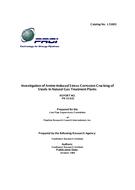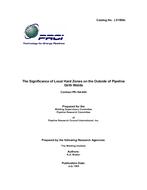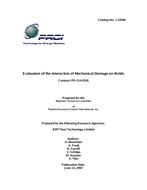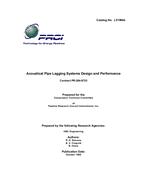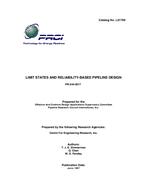Provide PDF Format
PRCI PR-15-633
- Investigation of Amine Induced Stress Corrosion Cracking of Steels in Natural Gas Treatment Plants
- Report / Survey by Pipeline Research Council International, 10/01/1989
- Publisher: PRCI
$125.00$249.00
L51603e
Southwest Research Institute
Need: The possibility of extensive SCC in natural gas treatment plants is of obvious concern to the gas transmission industry. As a result, PRCI initiated a research project at Southwest Research Institute (SwRI) to investigate the SCC susceptibility of carbon steels in MEA and DEA solutions typical of amine solutions used in natural gas treatment plants. The primary objectives of the project were: to determine the parameters responsible for cracking; and to determine modifications to plant equipment an&or process chemistry that might be used to control SCC in natural gas treatment plants.
Benefit: This report describes a research program that was conducted by Southwest Research Institute (SwRI): to determine the factors responsible for stress corrosion cracking (SCC) of steels in natural gas treatment plants using ethanolamine solutions to remove acid gases from natural gases; and to determine modifications to plant equipment and/or process equipment that might be used to control SCC in natural gas treatment plants.
Result: Conclusions drawn from data collected from other sources and generated in this program are summarized below. * Thermal stress relief of weldments is the most effective way to minimize SCC of steel components in amine plants. * SCC occurs at all operating temperatures, including temperatures below 100 degress F. * Steam out of amine plant components without prior water washing may accelerate SCC of steel components and should be avoided. * In natural gas treatment plants, steels were found to be about equally susceptible to SCC in MEA and DEA solutions. * SCC does not occur in pure 20 percent MEA or in pure 35 percent DEA solutions. * SCC susceptibility of the test materials at anodic potentials in solutions of both MEA and DEA results from the presence of CO2. * H2 S in small concentrations prevents cracking of A 516 steel in MEA and DEA solutions containing CO2. * The SCC susceptibility of the test steels is strongly potential dependent. A 516 and A 515 steels were susceptible to SCC in CO2 -containing MEA and DEA solutions at potentials near the active-to-passive transition potential, although the potential range in which the A 515 steel was susceptible to SCC was approximately 100 mV more negative than the potential range in which the A 516 material was susceptible. * A 516 test steel is susceptible to cracking at cathodic potentials in both MEA and DEA solutions, if the potential is below the hydrogen evolution potential in the solution. (The A 515 steel was not tested at cathodic potentials, but it is also is expected to be susceptible to cracking at cathodic potentials. * A 516 Grade 70 steel is susceptible to SCC in MEA solutions containing 500 ppm of Betz WS-58 inhibitor. The inhibitor lowered the potential range in which cracking occurs in CO2 -containing solutions by about 100 mV relative to uninhibited solutions of the same composition.
Southwest Research Institute
Need: The possibility of extensive SCC in natural gas treatment plants is of obvious concern to the gas transmission industry. As a result, PRCI initiated a research project at Southwest Research Institute (SwRI) to investigate the SCC susceptibility of carbon steels in MEA and DEA solutions typical of amine solutions used in natural gas treatment plants. The primary objectives of the project were: to determine the parameters responsible for cracking; and to determine modifications to plant equipment an&or process chemistry that might be used to control SCC in natural gas treatment plants.
Benefit: This report describes a research program that was conducted by Southwest Research Institute (SwRI): to determine the factors responsible for stress corrosion cracking (SCC) of steels in natural gas treatment plants using ethanolamine solutions to remove acid gases from natural gases; and to determine modifications to plant equipment and/or process equipment that might be used to control SCC in natural gas treatment plants.
Result: Conclusions drawn from data collected from other sources and generated in this program are summarized below. * Thermal stress relief of weldments is the most effective way to minimize SCC of steel components in amine plants. * SCC occurs at all operating temperatures, including temperatures below 100 degress F. * Steam out of amine plant components without prior water washing may accelerate SCC of steel components and should be avoided. * In natural gas treatment plants, steels were found to be about equally susceptible to SCC in MEA and DEA solutions. * SCC does not occur in pure 20 percent MEA or in pure 35 percent DEA solutions. * SCC susceptibility of the test materials at anodic potentials in solutions of both MEA and DEA results from the presence of CO2. * H2 S in small concentrations prevents cracking of A 516 steel in MEA and DEA solutions containing CO2. * The SCC susceptibility of the test steels is strongly potential dependent. A 516 and A 515 steels were susceptible to SCC in CO2 -containing MEA and DEA solutions at potentials near the active-to-passive transition potential, although the potential range in which the A 515 steel was susceptible to SCC was approximately 100 mV more negative than the potential range in which the A 516 material was susceptible. * A 516 test steel is susceptible to cracking at cathodic potentials in both MEA and DEA solutions, if the potential is below the hydrogen evolution potential in the solution. (The A 515 steel was not tested at cathodic potentials, but it is also is expected to be susceptible to cracking at cathodic potentials. * A 516 Grade 70 steel is susceptible to SCC in MEA solutions containing 500 ppm of Betz WS-58 inhibitor. The inhibitor lowered the potential range in which cracking occurs in CO2 -containing solutions by about 100 mV relative to uninhibited solutions of the same composition.

